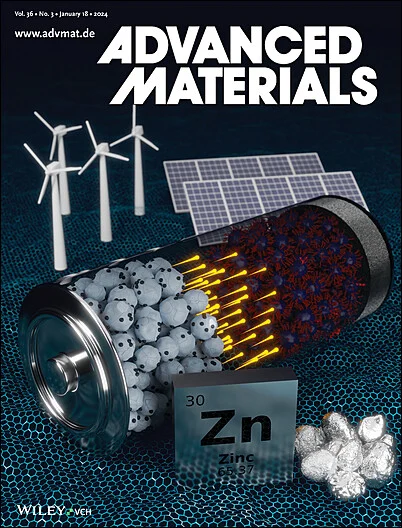让海水的界面太阳能蒸发比淡水更快
IF 27.4
1区 材料科学
Q1 CHEMISTRY, MULTIDISCIPLINARY
引用次数: 0
摘要
基于界面太阳能蒸发的海水淡化被认为是缓解淡水匮乏的最有前途的策略之一。然而,海水中无处不在的盐分极大地限制了实际海水的太阳能蒸发率。除了太阳能蒸发过程中盐分在蒸发表面积累这一常见问题外,盐离子与水分子之间的强水合作用也导致海水的蒸发率低于纯水。在此,我们提出了一种简单易行的通用策略来扭转这种情况,即让真实海水的蒸发速度快于纯水。只需在浮动光热蒸发器中引入特定的矿物材料,空气-水界面上的离子交换就会直接导致海水蒸发焓的降低,从而实现比纯水高得多的海水蒸发率。这一过程是在海水太阳能蒸发过程中自发实现的。考虑到目前以蒸发为基础的海水淡化厂所生产的大量清洁水,这种蒸发性能的改进可显著提高清洁水的年产量,使全球数百万人受益。本文章由计算机程序翻译,如有差异,请以英文原文为准。
Making Interfacial Solar Evaporation of Seawater Faster than Fresh Water
Interfacial solar evaporation‐based seawater desalination is regarded as one of the most promising strategies to alleviate freshwater scarcity. However, the solar evaporation rate of real seawater is significantly constricted by the ubiquitous salts present in seawater. In addition to the common issue of salt accumulation on the evaporation surface during solar evaporation, strong hydration between salt ions and water molecules leads to a lower evaporation rate for real seawater compared to pure water. Here a facile and general strategy is developed to reverse this occurrence, that is, making real seawater evaporation faster than pure water. By simply introducing specific mineral materials into the floating photothermal evaporator, ion exchange at air–water interfaces directly results in a decrease in seawater evaporation enthalpy, and consequently achieves much higher seawater evaporation rates compared to pure water. This process is spontaneously realized during seawater solar evaporation. Considering the current enormous clean water production from evaporation‐based desalination plants, such an evaporation performance improvement can remarkably increase annual clean water production, benefiting millions of people worldwide.
求助全文
通过发布文献求助,成功后即可免费获取论文全文。
去求助
来源期刊

Advanced Materials
工程技术-材料科学:综合
CiteScore
43.00
自引率
4.10%
发文量
2182
审稿时长
2 months
期刊介绍:
Advanced Materials, one of the world's most prestigious journals and the foundation of the Advanced portfolio, is the home of choice for best-in-class materials science for more than 30 years. Following this fast-growing and interdisciplinary field, we are considering and publishing the most important discoveries on any and all materials from materials scientists, chemists, physicists, engineers as well as health and life scientists and bringing you the latest results and trends in modern materials-related research every week.
 求助内容:
求助内容: 应助结果提醒方式:
应助结果提醒方式:


